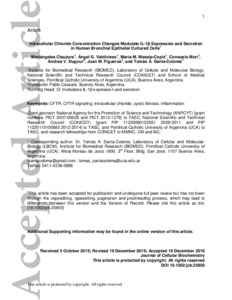Por favor, use este identificador para citar o enlazar este ítem:
https://repositorio.uca.edu.ar/handle/123456789/8778| Título: | Intracellular chloride concentration changes modulate IL-1β expression and secretion in human bronchial epithelial cultured cells | Autor: | Clauzure, Mariángeles Valdivieso, Ángel Gabriel Massip Copiz, María Macarena Mori, Consuelo Dugour, Andrea V. Figueroa, Juan M. Santa Coloma, Tomás Antonio |
Palabras clave: | CELULAS EPITELIALES; MARCADORES GENETICOS; FIBROSIS QUISTICA; INFLAMACION; ANIONES; CLORURO INTRACELULAR | Fecha de publicación: | 2017 | Editorial: | Wiley | Cita: | Clauzure M, Valdivieso ÁG, Massip‐Copiz MM, et al. Intracellular Chloride Concentration Changes Modulate IL-1β Expression and Secretion in Human Bronchial Epithelial Cultured Cells. Journal of Cellular Biochemistry. 2017;118(8):2131-2140. doi:10.1002/jcb.25850 Disponible en: https://repositorio.uca.edu.ar/handle/123456789/8778 | Resumen: | Abstract: Cystic fibrosis (CF) is caused by mutations in the CFTR gene, which encodes a cAMP-regulated chloride channel. Several cellular functions are altered in CF cells. However, it is not clear how the CFTR failure induces those alterations. We have found previously several genes differentially expressed in CF cells, including c-Src, MUC1, MTND4, and CISD1 (CFTR-dependent genes). Recently, we also reported the existence of several chloride-dependent genes, among them GLRX5 and RPS27. Here, varying the intracellular chloride concentration [Cl- ]i of IB3-1 CF bronchial epithelial cells, we show that IL-1β mRNA expression and secretion are also under Cl- modulation. The response to Cl- is biphasic, with maximal effects at 75 mM Cl- . The regulation of the IL-1β mRNA expression involves an IL-1β autocrine effect, since in the presence of the IL-1β receptor antagonist IL1RN or anti-IL-1β blocking antibody, the mRNA response to Cl- disappeared. Similar effects were obtained with the JNK inhibitor SP600125, the c-Src inhibitor PP2 and the IKK inhibitor III (BMS-345541). On the other hand, the IL-1β secretion is still modulated by Cl- in the presence of IL-1RN, IL-1β blocking antibody, or cycloheximide, suggesting that Cl- is affecting the IL-1β maturation/secretion, which in turn starts an autocrine positive feedback loop. In conclusion, the Cl- anion acts as a second messenger for CFTR, modulating the IL-1β maturation/secretion. The results also imply that, depending on its intracellular concentration, Cl- could be a pro-inflammatory mediator. J. Cell. Biochem. 118: 2131-2140, 2017. © 2016 Wiley Periodicals, Inc. | URI: | https://repositorio.uca.edu.ar/handle/123456789/8778 | ISSN: | 0730-2312 (impreso) 1097-4644 (online) |
Disciplina: | MEDICINA | DOI: | 10.1002/jcb.25850 | Derechos: | Acceso Abierto | Fuente: | Journal of Cellular Biochemistry. 2017;118(8):2131-2140 |
| Aparece en las colecciones: | Artículos |
Ficheros en este ítem:
| Fichero | Descripción | Tamaño | Formato | |
|---|---|---|---|---|
| intracellular-chloride-concentration-changes.pdf | 842,16 kB | Adobe PDF |  Visualizar/Abrir |
Visualizaciones de página(s)
240
comprobado en 05-ene-2026
Descarga(s)
481
comprobado en 05-ene-2026
Google ScholarTM
Ver en Google Scholar
Altmetric
Altmetric
Este ítem está sujeto a una Licencia Creative Commons

